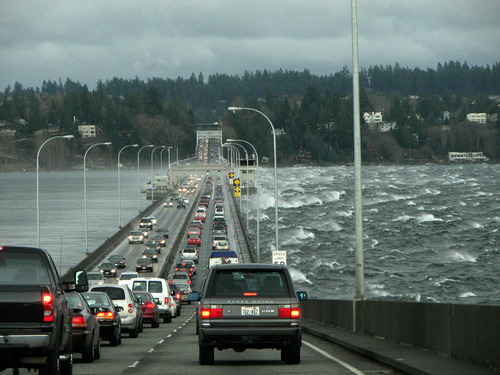A $7 billion investment in transportation could yield six times that in economic benefit and 184,000 jobs, the Washington Roundtable said in a new study Tuesday.
With the Legislature deadlocked on a transportation package valued at $10 billion to $12 billion over the last two sessions, the Roundtable study is a means of applying some pressure to lawmakers to get them to come back to the negotiating table, as costs balloon over time with inaction, the study said.
But transportation funding could also take a back seat to an upcoming legislative session that figures to be dominated by debate over basic education funding.
Steve Mullin, president of the Washington Roundtable, said the study is intended to remind legislators that inaction on transportation has inherent costs of wear and tear on highways, bridges that need replacing, bottlenecked highways, and delayed port expansions. The study estimates those conditions worsen over the next 12 years.
“We’re realistic about the political circumstances that we’re in,” Mullin said Tuesday afternoon in Olympia. “This is not going to get easier over time. It may be the best time that’s going to come along for awhile.”
The House and the Senate have split over the amount of gas tax increase needed for a transportation tax over the last two years, with majority Democrats in the House passed a 10.5-cent hike in the cost of a gallon of fuel to generate $10.5 billion out at the end of the 2013 session, while the conservative Majority Coalition Caucus says an 11.5-cent increase generating $12.2 billion is more appropriate. Neither side reached consensus by the end of this year’s session.
The Roundtable’s study, done by the Boston Consulting Group, winnows that down to $7 billion by only looking at projects and elements of each chamber’s package that had the broadest, bipartisan support and analyzes them, Mullin said. It doesn’t account for the state’s ferry system, mass transit needs or local governments’ road fixes, but they have economic benefits as well, he said.
It studies seven projects spread throughout the state in detail, all of which should be well-known to motorists in those regions:
- $1.3 billion to finish the Highway 520 replacement and HOV lane addition project
- $1.29 billion to add two express lanes to Interstate 405 from Bellevue to Renton
- $1.25 billion for maintenance and preservation of state highways
- $750 million to complete the North Spokane Corridor, extending US 395 to I-90
- $390 million to widen I-90 and improve safety at Snoqualmie Pass
- $1.66 billion for a new four-lane highway linking I-5 to Highway 167
- $350 million for additional lanes and repaving work on I-5 near Joint Base Lewis McChord.
The study estimates the spending would foster 184,000 jobs, mainly construction related, over the 12 years, Mullin said. Some other key findings included reduced the number of hours drivers spend in traffic by 4 million, saving individual drivers $160 per year in wear-and-tear costs, lowering supply-chain costs to businesses by $600 million, and saving the state $650 million in more expensive repairs later on by letting the roads get worse.
The study also estimates significant savings in carbon emissions from the reduction in congestion hours, as it says drivers would burn 1.7 million gallons of fuel less than they do currently.
Mullin cautioned that the Roundtable had not endorsed any specific plan, but had backed individual elements included.
“This is not a proposal of projects,” Mullin said. “It’s an analysis. The question of political feasibility is affected by all sets of factors. Particularly when you look at the cost of inaction, 12 years is not that far from now.”
Your support matters.
Public service journalism is important today as ever. If you get something from our coverage, please consider making a donation to support our work. Thanks for reading our stuff.




